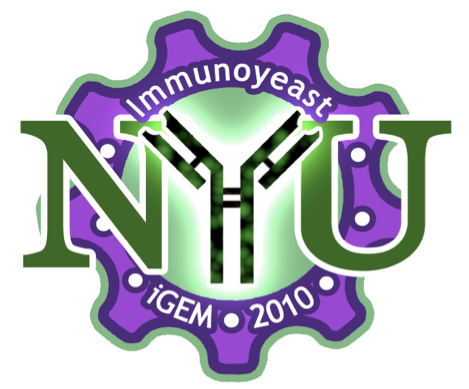Team:NYU/Notebook
From 2010.igem.org
| Home | Team | Project | BioBricks | Modeling | Notebook | Safety |
|---|
| You can write a background of your team here. Give us a background of your team, the members, etc. Or tell us more about something of your choosing. | |
|
Tell us more about your project. Give us background. Use this is the abstract of your project. Be descriptive but concise (1-2 paragraphs) | File:NYU team.png Your team picture |
| Team Example |
Contents |
Notebook
7/20/10
John: Performed digestion of 32 plasmids using either EcoRI, PstI, or both. These plasmids included RBS, Flag, E1, F1, sectag (multiple), NUB, and Strep. This was performed to see if our digestion enzymes were working correctly. After digestion, these solutions were run in 4 1.5 gels with large sized wells to verify if the enzymes were cutting.
7/21/10
John: Ran 1.5 % agarose gel to verify whether primers worked on the Nub-Fusion construct. Previously, we PCRed NUB-Fusion plasmid using verification primers. After, we used this product as a template for PCR with the NUB specific primers that we designed. Sec-tag was also PCRed and run on the gel. Additionally, old PCR cleanup NUB and Sectag were run on the gel to see if they can be used or disposed.
Harris: Transformations from the day before of ADH1-Aga2Linker and ECFP-Terminator in the Biobrick Chloramphenicol plasmid failed, although the retransformation of Aga2 (in the Amp plasmid) alongside them worked. Ligations left overnight so today I am retransforming them alongside BBa_K098994, which is 5B from Plate 3 of the initial distribution, and is in a Chloramphenicol resistance plasmid. This should grow up fine, and if it does, then we know that the problem is with the ligations, but if it doesn’t, then there is a problem with the Chloramphenicol plates.
7/22/10
- Russell:
PCR results from 7/20 were disappointing but not unforeseen. Previous sec tag PCRs show band of appropriate size, but biobricking attempts have been unsuccessful with cause unknown. Will perform one more biobricking procedure on the sec tag under careful scrutiny before troubleshooting for larger problems.
Transformed the N-terminal and C-terminal GFP biobricks from the initial distribution. These will be used to show that the test scFv and test antigen are, in fact, complexing in the cytoplasm (and maybe on the surface).
Miniprepped the Gal4 and VP16 biobricks to use as a Gal1-10 promoter activator for the response system.
7/25/10
- Russell:
Harris’ transformations of pADH1:Aga2-Linker and ECFP:Terminator assembly were successful. I inoculated 4 colonies from each assembly product in LB+Chloramphenicol and performed colony PCRs.
REALIZED THERE IS NO RBS BETWEEN THE pADH1 PROMOTER AND AGA2!
Retransformation of the secretion tag biobricking ligation was also successful. I inoculated 6 colonies from the two plates and performed colony PCR.
Transformation of the split-GFP biobricks (N-terminal and C-terminal halves of GFP) from the iGEM initial distribution was successful – inoculated 3 colonies of each biobrick but had already started thermal cycler, so colony PCR will be done later.
Ordered second set of Nub primers as well as biobrick-compatible primers for manipulating the backbone of pCTCON.
7/26/10
- Russell:
Got sequencing results from Genewiz for both of the supposed N-ub fusions we received from iGEM – neither sequence contained Nub, apparently both plasmids are void.
Instead of excising from a plasmid, we get to build the part via overlapping PCR (which, luckily, I’ve been wanting to try for awhile). So I broke the ~140bp Nub gene down into 3 overlapping sequences and ordered the appropriate oligos for the PCR.
7/28/10
- Russell:
Received both orders from IDT. Performed two overlap PCRs with different concentrations of oligos. Will run on a gel tomorrow with some Biobrick verification PCRs.
- John:
Research potential providers of scFv and antigen parts. Made transformation media and SOB.
7/29/10
- Russell:
Constructed the pCTCON plasmid backbone with BIOBRICK ends through PCR amplification. [extremely long cycle - 5:30 ext. time]
I ran this on a gel with the overlap NUB builds from yesterday and 6 biobrick verification PCRs of Aga2:Linker:eCFP:Term colonies
- John:
Email out requests for potential scFv and antigen parts.
 "
"
